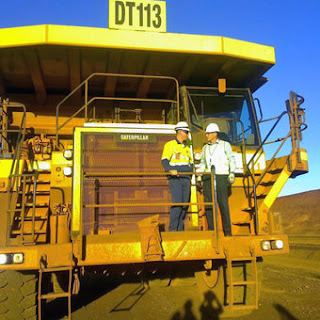Some Australian mine workers may soon find themselves trading in their steel-toed boots for a headset and computer mouse, as mining companies automate to help plug labor shortages and ramp up output to feed Asia's voracious demand for minerals. Jobs in Australia's Outback mines can mean grueling 12-hour days, scorching temperatures and long commutes — conditions perfect for machines from driverless trucks to drilling robots.
The resources industry has roughly $400 billion in new projects on the drawing board in Australia and, along with the construction industry, will need an additional 260,000 workers over the next five years, according to government estimates. "There's a shortage of skilled and un-skilled workers and that tends to lead to automation, certainly companies will be looking at that more at the current time," said Colin Hamilton, a commodities analyst with Macquarie in London. The use of remote-controlled mining could even replace one of the stock characters of Australia's mining bonanza — the truck driver without a degree who can rake in more than $100,000 per year.
Rio Tinto recently announced plans to double its fleet of driverless mining trucks at its Yandicoogina mine, the largest in Australia's Pilbara outback iron ore district. A guidance system, in a box near the front bumper, and a couple of radar-dish sensors remotely steer the trucks, which are otherwise identical to the towering yellow-painted behemoths that lumber through Pilbara's red-rust landscape.
"They will be doing everything. The whole (mining) pit will be fully autonomous — nothing that goes in or out of there that's not on a computer screen," Gervase Greene, spokesman for Rio Tinto, said. "It works from an efficiency point of view fantastically. You'll find load time is quicker, they are always in position, exactly the same position."
Rio Tinto already runs many of its mines from a center in Perth, some 1,500 km away from the Pilbara. At the operating center, which resembles a NASA control room and is far removed from the dusty outback, employees sit in front of desks with multiple screens detailing mine operations. From the serene atmosphere of the control room, Rio employees guide machines that do most of the work at the mines - from loading trains and ships to controlling mine power and water supply, Greene said. Rio had even begun investing in driverless trains, but suspended the program as it tried to cut back on costs when the global financial crisis hit. Hancock Prospecting Pty, owned by Australia's richest person, Gina Rinehart, will soon follow suit with remote operating centers in Perth for its Roy Hill iron ore mine and in Brisbane for coal mining.
"There are a whole bunch of reasons for doing it - to reduce costs, improve safety, and improve quality, increase capacity, improve productivity, reduce waste. Down the list, I think, it is to replace people," said Jock Cunningham, an automation expert at the Commonwealth Scientific and Industrial Research Organization (CSIRO).
Fewer Accidents
Rapidly growing Asian economies such as China and India have kept Australia's miners producing at breakneck speed, 24 hours a day, seven days a week. With production set to pick up and major miners planning to pour money into expanding operations, having robots do the job speeds operations up.
"Machines tend not to get tired — they will just keep doing the same thing over and over again... plus they are able to work through shift breaks and reduce travel time," Cunningham said. Companies typically need to see a 10 to 20 percent annual saving or improved productivity to encourage investment in high-cost robots, he said. Off-the-shelf technology can take about a year to pay off, while companies developing bespoke technology can wait up to ten years to break even, he said.
Some of the machines - such as the popular Load, Haul, Dump or LHD vehicle - can be sent into mine shafts for long periods of time, saving humans from deep descents which can put them in hazardous situations. From a mining company's point of view, cutting the number of accidents can be advantageous as well. "...that's a huge cost, it's a huge cost to a company's reputation and a risk as far as we're concerned," said Cheryl Edwardes, head of government relations for Hancock Prospecting.
Responding to Union Pressure?
Automation has gained cautious union support for its potential to improve safety. "There are some benefits to automating some of the work that's been traditionally quite dangerous - we've still got an unacceptable number of deaths in the mining industry," Unions Western Australia Secretary Simone McGurk said. Although miners emphasize that they do not intend to substitute robots for people, some say union pressure could be one of the factors driving automation.
Western Australia's Pilbara is not unionized, but unionized coal miners in the eastern Queensland state are in a dispute with BHP Billiton and Mitsubishi. "Given the current situation of the growing standoff between mining unions and some of the nations big miners, there's somewhat of a longer term incentive to potentially reduce employee numbers," said Gavin Wendt, senior resources analyst at Mine Life.
Using robots to do some of the more backbreaking jobs is another potential advantage. "What we do is we take the people out of those jobs in the pit and put them somewhere where they are doing better stuff. They are not getting replaced by (driverless) trucks by no means -- not one person," Rio Tinto's Greene said.
Still, CSIRO's Cunningham says some mining jobs will likely become extinct, just as the computer phased out the typing pool. "The new breed of operators that are coming through - the Gen Y operators - are very savvy to virtual interfaces and remote control," Cunningham said. "They like this stuff and that's what they expect to find in the industry rather than working behind a steering wheel or gear shift... a mining company that has that higher level will probably be more attractive to young employees."









